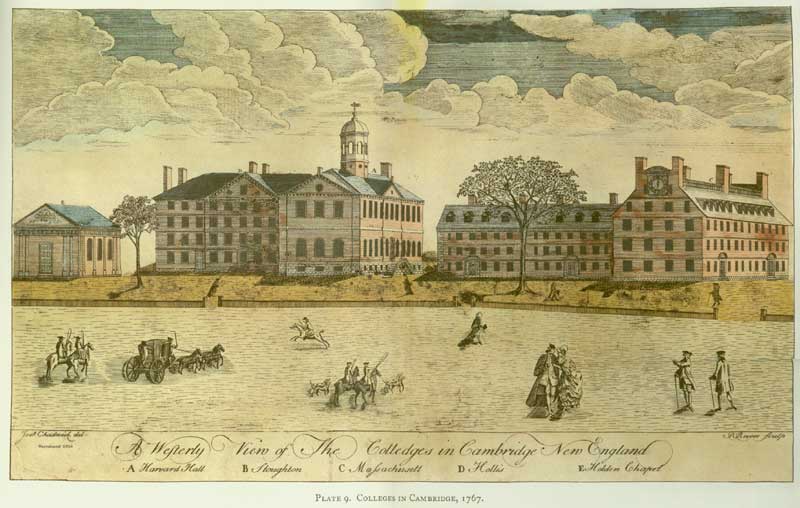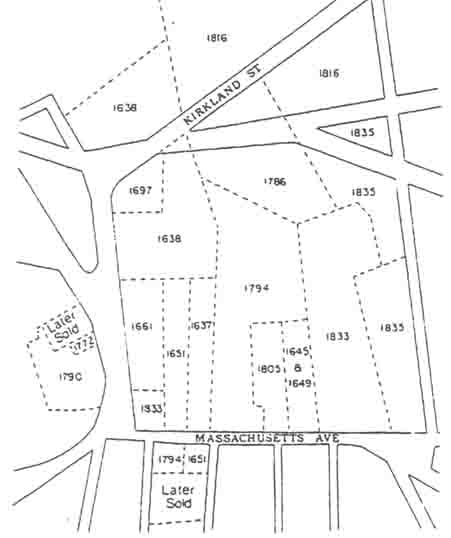A Brief History of Colonial Harvard
The institution that was to become Harvard College was established
in 1636 by the General Council of Massachusetts, the first
college to be founded in North America. It was intended to
imitate the nature and purpose of many of the first Puritans’
English alma maters. The Council appropriated £400 –
almost half the tax levy for that year – to establish
a college that would educate the colony’s future ministers,
teachers, professionals, and public servants.
The site of the first college building was an old ox pasture
in what was to become Cambridge. This secluded address was
chosen because Cambridge was free of anti-academicism
of the kind that
Anne Hutchinson was stirring up in nearby Boston. When a
young, undistinguished pastor from nearby Charlestown bequeathed
his
library of 329 books and half of his estate to the college
in 1638, it was named Harvard in his honor.
Stability was not easily assured, however. Within a year
of the bequest, the administration had dismissed the
first master
on
charges of “cruel and barbarous beatings” of
students and the college was forced to close. The college
languished for
almost a year before the Board of Overseers appointed Henry
Dunster as president, an event that could justly be considered
the second
foundation of Harvard College.
By the time Dunster resigned in 1654 Harvard had become an
internationally-recognized university with several campus
buildings and a growing endowment,
administered under a legal Charter. By 1650, the year when
the college graduated its first American-born student, the
class
size had risen from a handful to close to fifty students
drawn from across New England.
Five years later, buoyed by the college’s success,
John Eliot and President Dunster began an ill-fated experiment
to bring Native Americans to Harvard in hopes of converting
and ‘civilizing’ them. While their efforts produced
a Bible printed in the Algonkian language, the Indian
College only ever served a handful of students, most notably
John Sassamon whose English education cost him his life and
initiated King Philip’s War. In 1665, with only one
fully-graduated student to its name, the Indian College was
disbanded.
For the next one hundred years, the college focused its efforts
on educating the colony’s future leaders. Emphasizing
the study of liberal arts over theology, the rigorous colonial
curriculum
(based upon the medieval trivium and quadrivium) offered
a progressive schedule that began with Latin, Greek, Logic,
Hebrew and Rhetoric
and culminated in advanced study of Physics, Philosophy,
and Mathematics with the option of studying Divinity at the
Master’s
level.
Students, however, had other ideas about the purpose of a
Harvard education. By the early-eighteenth century, the region’s
newly prosperous port cities were sending growing numbers
of their sons to Cambridge in the hope of creating young gentlemen.
Thinking of their education in terms of fashion, refinement,
and proper manners, Harvard students of the new century seemed
to place their academic interests second to their extra-curricular
pursuits. When a fire destroyed Harvard Hall, a list of claims
for replacement items included pipes, tobacco, liquors, punch
bowls, glasses, and tea sets. Only one Bible was reported
as lost.

Paul Revere. A Westerly View of The Colledges in Cambridge
New England, 1767.
The students’ taste for luxury made them vocal opponents
of the series of British tax levies that precipitated the
American Revolution. In indignant response to the Tea Act
and the Townshend duties on paper, seniors voted to abstain
from tea drinking and insisted that their degrees be printed
on domestically manufactured paper by the patriot newspaper
presses.
In October 1775 the students temporarily relocated to Concord
so that the college buildings could be requisitioned to provide
lead roofing for patriot bullets and billet for more than
1500 continentals. While many students and alumni fought
in the
conflict, including General Artemas Ward (class of 1748),
it was with the
pen rather than the sword that Harvard’s sons made
the most difference. Men like James Bowdoin (class of 1745)
and John
Adams (class of 1755) served among the first generation of
governors and legislators in the new republic.
The disruptions caused by war served to temporarily depress
enrollments through the 1780s, but by then the college was
already firmly established. A faculty of nine, a library of
5,000 items, and a continuous building program made Harvard
an intellectual institution of imposing stature. In 1780 the
authority of Harvard’s administration was guaranteed
in perpetuity by the Massachusetts Constitution, setting the
stage for the college’s almost unchecked nineteenth-century
expansion, during which Harvard became the nation’s
university and a serious rival to the European colleges from
whose roots it had sprung.
Bibliography
Bailyn, Bernard. "Foundations." In Glimpses
of the Harvard Past, edited by Bernard Bailyn, 1-18.
Cambridge, Massachusetts: Harvard University Press, 1986.
Morison, Samuel Eliot. The Founding of Harvard College.
Cambridge, Massachusetts: Harvard University Press, 1935.
———. Three Centuries of Harvard College.
Cambridge, Massachusetts: Harvard University Press, 1936.
Rick Bell

John D. Burton. The growth of the Harvard Yard campus, 1638-1835. |